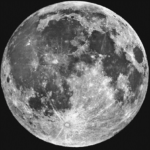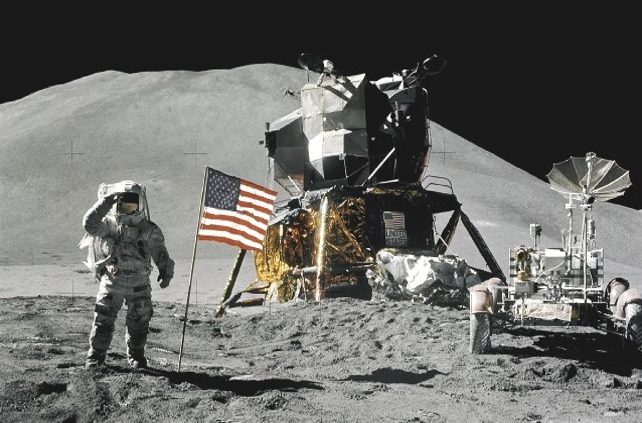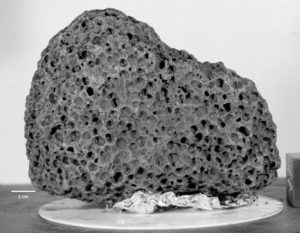Dr. Gary Lofgren: Planetary Geology and Lunar Rocks
For those of you who’ve wondered what the ‘dark’ side of the moon looks like, how earth rocks are different from moon rocks or if earth time would change forever without the moon – these questions and many more were answered when Doctor Gary Lofgren, retired NASA Geologist, Trainer of Astronauts and Curator of the Lunar Sample Laboratory at the Johnson Space Center spoke at the July 21st meeting of the Lindheimer Master Naturalists.
 Dr. Lofgren says that he didn’t always know he would grow up to be a geologist, but a lifelong interest in geology began when he was a child, picking up interesting rocks and later collecting and studying rock specimens. When he and his family moved from Minnesota to California, he saw geologic features across the “Badlands” of South Dakota through Yellowstone National Park to the Pacific coast area that cemented his interest in geology. A report he wrote about the Russian ‘Sputnik’ satellite in high school was his first extraterrestrial research project and possible precursor for his distinguished career with NASA and the space program.
Dr. Lofgren says that he didn’t always know he would grow up to be a geologist, but a lifelong interest in geology began when he was a child, picking up interesting rocks and later collecting and studying rock specimens. When he and his family moved from Minnesota to California, he saw geologic features across the “Badlands” of South Dakota through Yellowstone National Park to the Pacific coast area that cemented his interest in geology. A report he wrote about the Russian ‘Sputnik’ satellite in high school was his first extraterrestrial research project and possible precursor for his distinguished career with NASA and the space program.
He received a scholarship to undergraduate school at Stanford University. Dr. Lofgren says that sitting in the auditorium with other freshmen, he was called upon to declare a major – “that I could always change it. I wrote ‘Geology’ in the box.” He went on to complete that BA degree in Geology; then a Master’s degree in Geology from Dartmouth University; and a Ph.D. also in Geology from Stanford in 1968.
His professional career in the geology of other interplanetary bodies began when he was recruited by NASA in 1968 to study the crystallization textures of Lunar Rocks. He received his Ph.D. from Stanford University in that same year and began his incredible 45-year career during which humankind first stepped on the moon. Within a very short time, Dr. Paul Gast, leader of the Geo-Science management of the Manned Spacecraft Center selected Dr. Lofgren as a member of a team of geologists led by the United States Geological Survey USGS who gave astronauts the knowledge to describe the lunar surface and collect appropriate rock and other samples.
This specialized team of geologists conducted the field exercises with the astronauts in various locations on earth that were selected largely because of their similarity to the lunar landscape. Dr. Lofgren traveled with Apollo 13 and 15 crews to Hawaii, which he describes as a great geological area with some of the best exposures of volcanic rocks. Other training localities included Rio Grande Gorge Taos, NM, Buell Park, AZ, Ubehebe Crater, Death Valley, CA, Northern Minnesota, Medicine Hat, Canada and the San Juan Mountains, CO.
Included in crew training were problem solving activities (the geologic thought process in the field), designed to develop common geologic language, observation and description skills. The crews also underwent extensive training in moon rock type recognition, navigation of the moonscape and collection of rock and soil samples. Among the more challenging aspects of training the astronauts in lunar geology was the use of the photographic equipment. The Hasselblad camera, used on the Apollo Missions, had no viewfinder, making it necessary for the astronauts to become skilled with the video equipment to the extent that they could literally “point and click” and retrieve a unique photo of a lunar feature or landscape.
The astronauts also had to be trained to make decisions on which features were of greatest significance (within the limited time they had for each lunar task), then to photograph them from various angles, using a specially designed geological color scale or ‘gnomon’ which was used as a reference to establish vertical sun angle, scale and lunar color.
Between 1969 and 1972, six Apollo missions brought back 382 kilograms of lunar rocks, core samples, pebbles, sand and dust. The space flights returned 2,200 separate samples from six different explorations sites. This irreplaceable material was preserved in sterilized airtight containers and stored in the Lunar Sample Receiving Laboratory on the Johnson Space Center campus and in vaults across the JSC campus. Beginning in 1972 Dr. Lofgren was assigned the job of building and utilizing a laboratory to study the crystallization of minerals in silicate melts to contribute to the understanding of the formation of lunar rocks. Also during that decade, Dr. Lofgren worked with other scientists to design a permanent repository for the lunar material. On July 20, 1979, after two years of construction, the Lunar Sample Laboratory Facility in Building 31N at Johnson space Center was dedicated and remains NASA’s chief repository for materials returned from the moon during the Apollo era. Built for a cost of $2.5 million, the two-story, 14,000 sq. ft. facility provides permanent storage of the lunar sample collection in a physically secure and non-contaminating environment.
“The facility is incredibly well designed.” said Dr. Lofgren “There were several National Academy of Science members on the committee that laid out the science requirements for the building and reviewed designs to ensure their inputs were implemented. They anticipated every contingency you can imagine to safeguard the samples.” Since the beginning, scholars and universities have requested samples for study. The lab now allocates about 200 to 400 samples each year to scientists. As Curator of the Lunar Sample Facility until his retirement in 2013, Dr. Lofgren says that while early studies of the samples focused on reconstructing the overall structure of the moon, today scientists also study the samples to conduct comparative planetology studies and to take advantage of recent improvements in analytical instruments in the field of isotope geochemistry.
“We are now convinced that we have samples from Mars, among them meteorites that have come to Earth.” said Lofgren “We have samples from the moon, and we have, of course, samples from Earth. And we have samples of meteorites that preceded the formation of the planets. So we have samples from four different planetary entities. Scientists do what is called ‘comparative planetology’. Samples from one of those four entities are studies, and then those properties that were studied in one are studied in another to see how properties vary among planetary entities.”
Lofgren goes on to say, “We have samples from only six lunar sites. Just imagine if you had samples from only six places on Earth. There would be a lot you would not know. Specifically, we still don’t understand the full breadth of the evolution of the moon. We need a broader range of samples to capture the history of the evolution of the planet.”
Dr. Lofgren is enjoying retirement with his wife PJ Burkett, Ph.D. (in oceanography) in their Canyon Lake home.
Lunar Observations
Origin of the Moon:
When bodies were being formed in the solar system and Earth was still a seething, cooling body (500 – 700 million years after it was formed), a smaller body collided with Earth. While Earth survived the impact, a large amount of debris was scattered, forming a circle (rather like Saturn’s rings) which then accreted to form a body of similar composition – our Moon! It included the same isotropic signature as the Earth, including most of the elements in our periodic table. The same primitive materials are found on both Earth and Moon. This had been hypothesized by Dr. Bill Hartman, University of Arizona, prior to the Apollo missions – which actually brought conclusive evidence when analyzed by geochemists working with the project.
Differences between Earth and Moon:
There are only a few and deep traces of water on the Moon. There is no ‘free’ (uncombined with other elements) oxygen. The Moon has only trace amounts of water largely because there is no magnetic field to deflect the solar wind which sweeps away all surface water molecules. Low gravity also aids in this process. Moon rocks are pristine clean – no oxidation = no rust! Iron found on the moon is shiny silver in appearance. Colors on the Moon are gray. Since there is no atmosphere, there is more exposure to cosmic rays, the amount of which would destroy living creatures (such as humans) within an as yet undetermined amount of time. The study of the effects of cosmic rays on lunar rocks aids scientists in the determination of their age. There is no erosion on the Moon as on Earth, as the only force of degradation is impact from other bodies (meteors etc.). Moon rocks exhibit ‘zap pits’ which are formed by cosmic debris impacting the lunar rocks and aid in the identification of their age. Additional differences result from volatilization of some elements such as NA and K, common in Earth rocks.
The Surface of the Moon:
The surface of the Moon is covered by rubble – largely piles of rock fragments and dust, called the lunar regolith. It contains a unique radiation history of the Sun which is of importance in understanding climate changes on Earth. The lunar surface features are all older than any surface features on Earth because there is no erosion on the Moon.
General Lunar Characteristics:
The Moon is not a primordial object; it is an evolved terrestrial planet with internal zoning similar to that of Earth.
The Moon is ancient and still preserves its early history (the first billion years) that must be common to all terrestrial planets.
The youngest Moon rocks are as old as the oldest Earth rocks. The earliest processes and events probably affected both Earth and Moon, but can now only be found on the Moon.
The Moon and Earth are genetically related and formed from different proportions of a common reservoir of materials.
The Moon is lifeless; it contains no living organisms, fossils, or native organic compounds.
All Moon rocks originated through high-temperature processes with little or no involvement with water. They are roughly divisible into three types: basalts, anorthosites, and breccias.
Early in its history, the Moon was melted to great depths to form a “magma ocean.” The lunar highlands contain the remnants of early, low density rocks that floated to the surface of the magma ocean.
The lunar magma ocean was followed by a series of huge asteroid impacts that created basins which were later filled by lava flows.
The Moon is slightly asymmetrical in bulk form, possibly as a consequence of its evolution under Earth’s gravitational influence. Its crust is thicker on the far (dark) side, while most volcanic basins – and unusual mass concentrations, occur on the near side.
The Moon’s gravitational pull on the earth is responsible for the stability of Earth’s (approximate) 23.5-degree tilt on its axis and the reason that we have regular seasons.





